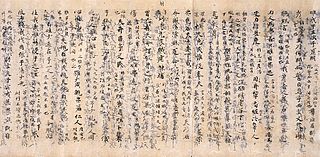Chinese classic texts or canonical texts or simply dianji (典籍) refers to the Chinese texts which originated before the imperial unification by the Qin dynasty in 221 BC, particularly the "Four Books and Five Classics" of the Neo-Confucian tradition, themselves a customary abridgment of the "Thirteen Classics". All of these pre-Qin texts were written in either Old or Classical Chinese. All three canons are collectively known as the Classics.

The Xia dynasty is the first dynasty in traditional Chinese historiography. According to tradition, the Xia dynasty was established by the legendary Yu the Great, after Shun, the last of the Five Emperors, gave the throne to him. In traditional historiography, the Xia was later succeeded by the Shang dynasty.

Shandong is a coastal province of the People's Republic of China and is part of the East China region.

Chinese mythology is mythology that has been passed down in oral form or recorded in literature throughout the area now known as Greater China. Chinese mythology includes many varied myths from regional and cultural traditions. Much of the mythology involves exciting stories full of fantastic people and beings, the use of magical powers, often taking place in an exotic mythological place or time. Like many mythologies, Chinese mythology has in the past been believed to be, at least in part, a factual recording of history. Along with Chinese folklore, Chinese mythology forms an important part of Chinese folk religion and Taoism, especially older popular forms of it. Many stories regarding characters and events of the distant past have a double tradition: ones which present a more historicized or euhemerized version and ones which present a more mythological version.

King Wu of Zhou was the founder and first king of the Zhou dynasty. The chronology of his reign is disputed but is generally thought to have begun around 1046 BCE and ended with his death three years later.

Qi, or Ch'i in Wade–Giles romanization, was a regional state of the Zhou dynasty in ancient China, whose rulers held titles of Hou (侯), then Gong, before declaring themselves independent Kings. Its capital was Linzi, located in present-day Shandong. Qi was founded shortly after the Zhou conquest of Shang, c. 1046 BCE. Its first monarch was Jiang Ziya, minister of King Wen and a legendary figure in Chinese culture. His family ruled Qi for several centuries before it was replaced by the Tian family in 386 BCE. Qi was the final surviving state to be annexed by Qin during its unification of China.

Yuan Shao, courtesy name Benchu (本初), was a Chinese military general, politician, and warlord who lived in the late Eastern Han dynasty. He occupied the northern territories of China during the civil wars that occurred towards the end of the Han dynasty. He was also an elder half-brother of Yuan Shu, a warlord who controlled the Huai River region, though the two were not on good terms with each other.

Tiān (天) is one of the oldest Chinese terms for heaven and a key concept in Chinese mythology, philosophy, and religion. During the Shang dynasty, the Chinese referred to their highest god as Shàngdì or Dì. During the following Zhou dynasty, Tiān became synonymous with this figure. Before the 20th century, worship of Tiān was an orthodox state religion of China.

Yu the Great (大禹) or Yu the Engineer was a legendary king in ancient China who was famed for "the first successful state efforts at flood control," his establishment of the Xia dynasty which inaugurated dynastic rule in China, and his upright moral character. He figures prominently in the Chinese legend of "Great Yu Controls the Waters".

Qufu is a city in southwestern Shandong province, East China. It is located about 130 kilometres (81 mi) south of the provincial capital Jinan and 45 km (28 mi) northeast of the prefectural seat at Jining. Qufu has an area of 815 square kilometers, and a total population of 653,000 inhabitants, of which, 188,000 live in urban areas.

Kong Rong, courtesy name Wenju, was a Chinese poet, politician, and minor warlord who lived during the late Eastern Han dynasty of China. He was a 20th generation descendant of Confucius. As he was once the Chancellor of Beihai State, he was also known as Kong Beihai. He was defeated by Yuan Tan in 196 and escaped to the capital Xuchang. For being a political opponent of Cao Cao and humiliating him on multiple occasions, Kong Rong was eventually put to death on various charges.

The Book of Documents is one of the Five Classics of ancient Chinese literature. It is a collection of rhetorical prose attributed to figures of ancient China, and served as the foundation of Chinese political philosophy for over two millennia.
According to Sima Qian, Confucius said: "The disciples who received my instructions, and could themselves comprehend them, were seventy-seven individuals. They were all scholars of extraordinary ability." It was traditionally believed that Confucius had three thousand students, but that only 72 mastered what he taught. The following is a list of students who have been identified as Confucius's followers. Very little is known of most of Confucius's students, but some of them are mentioned in the Analects of Confucius. Many of their biographies are recorded in the Sima Qian's Shiji. The Six Arts were practiced by the 72 disciples.

Jining former capital of Shandong. Is a prefecture-level city in southwestern Shandong province. It borders Heze to the southwest, Zaozhuang to the southeast, Tai'an to the northeast, and the provinces of Henan and Jiangsu to the northwest and south respectively. Jining, which is located directly to the north of Lake Nanyang, is today the northernmost city reachable by navigation on the Grand Canal of China making it an important inland port.

Linyi is a prefecture-level city in the south of Shandong province, China. As of 2011, Linyi is the largest prefecture-level city in Shandong, both by area and population, Linyi borders Rizhao to the east, Weifang to the northeast, Zibo to the north, Tai'an to the northwest, Jining to the west, Zaozhuang to the southwest, and the province of Jiangsu to the south. The name of the city Linyi (临沂) literally means "close to the Yi River".

The end of the Han dynasty was the period of Chinese history from 189 to 220 CE, roughly coinciding with the tumultuous reign of the Han dynasty's last ruler, Emperor Xian. It was followed by the Three Kingdoms era. During the end of the Han dynasty, the country was thrown into turmoil by the Yellow Turban Rebellion (184–205). Meanwhile, the Han Empire's institutions were destroyed by the warlord Dong Zhuo and fractured into regional regimes ruled by various warlords, some of whom were nobles and officials of the Han imperial court. The warlord Cao Cao took control of Emperor Xian and his court in 196 and began gradually reunifying the empire. Cao Cao ostensibly operated under Emperor Xian's rule, though in reality the emperor was a hostage.
The term Nine Provinces or Nine Regions, is used in ancient Chinese histories to refer to territorial divisions or islands during the Xia and Shang dynasties and has now come to symbolically represent China. "Province" is the word used to translate zhou (州) – since before the Tang dynasty, it was the largest Chinese territorial division. Although the current definition of the Nine Provinces can be dated to the Spring and Autumn and Warring States periods, it was not until the Eastern Han dynasty that the Nine Provinces were treated as actual administrative regions.
The Si River is a river in Shandong Province, China. It also ran through the area of modern Jiangsu Province until floods in 1194.

Yanzhou is a district in the prefecture-level city of Jining, in the southwest of Shandong province, People's Republic of China. It was also the name of one of the Nine Provinces in ancient China, where Yu combated floods by water control.
The Yu Gong or Tribute of Yu is a chapter of the Book of Xia (夏書/夏书) section of the Book of Documents, one of the Five Classics of ancient Chinese literature. The chapter describes the legendary Yu the Great and the provinces of his time. Most modern scholars believe it was written in the fifth century BCE or later.
















